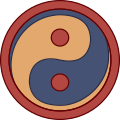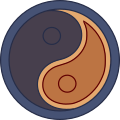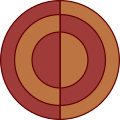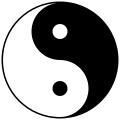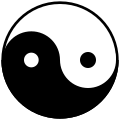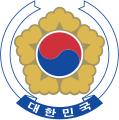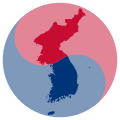Yin Yang
Jump to navigation
Jump to search
English: The yin yang symbol consists in its most recognized form of a pair of inverted commata. Its most prominent use occurs in Taoist philosophy, but its essential shape can also be found in other cultures and even in nature. The list is arranged in chronological order.
In nature
[edit]-
Naturally grown wood
-
Café au lait
-
Flower bed at Beelitz-Heilstätten in Germany
-
Detail of enamelled bronze plaque
-
Yin yang whorl in a triskele arrangement
-
Yin yang swirls on bronze plaque
-
Detail of bronze plaque
-
Yin yang swirls arranged circularly on gold-plated bronze disc
-
Detail of gold-plated bronze disc
Roman Notitia Dignitatum
[edit]Copy in Bodleian Library
[edit]-
Armigeri defensores seniores (4th row, 3rd from left)
-
Mauri Osismiaci (4th row, 2nd from left)
-
Thebaei (4th row, center)
Modern reproductions of Bodleian version
[edit]-
Armigeri defensores seniores
-
Mauri Osismiaci
-
Thebaei
Copy in Bayerische Staatsbibliothek
[edit]-
Armigeri defensores seniores
-
Armigeri defensores seniores
-
Mauri Osismiaci
-
Mauri Osismiaci
-
Thebaei
-
Thebaei
The white areas in the symbols in this section are all filled white. Some similar SVGs on Commons are transparent (unfilled) instead.
-
No border; needs a colored background to be visible
-
No border; no dots
-
No border, ancient hetu form
-
Simple outline without fill
-
Light-weight outline for large display
-
Feathered border for a white background
-
Feathered border
-
Feathered border
-
Thin border
-
Thin border
-
Thin border, counter-clockwise
-
Thin border, counter-clockwise, reversed
-
Thin border, horizontal
-
No dots
-
No dots
-
Ancient form
-
Ancient form
-
No border, blue and red
-
No border, no dots, blue and red
-
Ancient form, blue and red
-
Recursive
-
With Red Crystal
-
Ancient form by Lai Zhide
-
With Bagua
-
Kugel
-
Flag of the Dadao Municipal Government of Shanghai












